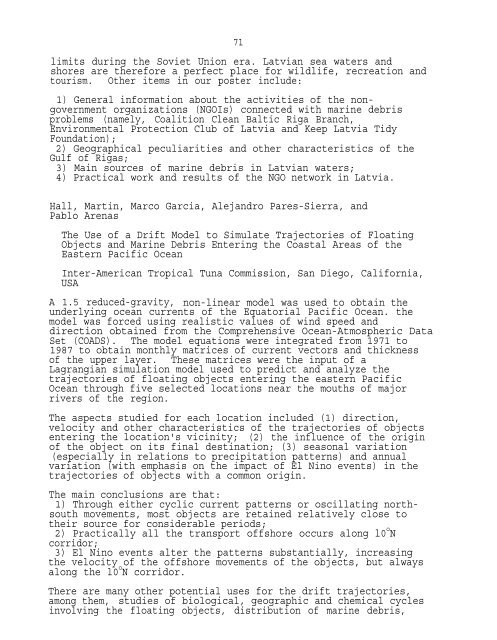Poster abstracts and manuscripts from the Third International ...
Poster abstracts and manuscripts from the Third International ...
Poster abstracts and manuscripts from the Third International ...
You also want an ePaper? Increase the reach of your titles
YUMPU automatically turns print PDFs into web optimized ePapers that Google loves.
71<br />
limits during <strong>the</strong> Soviet Union era. Latvian sea waters <strong>and</strong><br />
shores are <strong>the</strong>refore a perfect place for wildlife, recreation <strong>and</strong><br />
tourism. O<strong>the</strong>r items in our poster include:<br />
1) General information about <strong>the</strong> activities of <strong>the</strong> nongovernment<br />
organizations (NGOIs) connected with marine debris<br />
problems (namely, Coalition Clean Baltic Riga Branch,<br />
Environmental Protection Club of Latvia <strong>and</strong> Keep Latvia Tidy<br />
Foundation);<br />
2) Geographical peculiarities <strong>and</strong> o<strong>the</strong>r characteristics of <strong>the</strong><br />
Gulf of Rigas;<br />
3) Main sources of marine debris in Latvian waters;<br />
4) Practical work <strong>and</strong> results of <strong>the</strong> NGO network in Latvia.<br />
Hall, Martin, Marco Garcia, Alej<strong>and</strong>ro Pares-Sierra, <strong>and</strong><br />
Pablo Arenas<br />
The Use of a Drift Model to Simulate Trajectories of Floating<br />
Objects <strong>and</strong> Marine Debris Entering <strong>the</strong> Coastal Areas of <strong>the</strong><br />
Eastern Pacific Ocean<br />
Inter-American Tropical Tuna Commission, San Diego, California,<br />
USA<br />
A 1.5 reduced-gravity, non-linear model was used to obtain <strong>the</strong><br />
underlying ocean currents of <strong>the</strong> Equatorial Pacific Ocean. <strong>the</strong><br />
model was forced using realistic values of wind speed <strong>and</strong><br />
direction obtained <strong>from</strong> <strong>the</strong> Comprehensive Ocean-Atmospheric Data<br />
Set (COADS). The model equations were integrated <strong>from</strong> 1971 to<br />
1987 to obtain monthly matrices of current vectors <strong>and</strong> thickness<br />
of <strong>the</strong> upper layer. These matrices were <strong>the</strong> input of a<br />
Lagrangian simulation model used to predict <strong>and</strong> analyze <strong>the</strong><br />
trajectories of floating objects entering <strong>the</strong> eastern Pacific<br />
Ocean through five selected locations near <strong>the</strong> mouths of major<br />
rivers of <strong>the</strong> region.<br />
The aspects studied for each location included (1) direction,<br />
velocity <strong>and</strong> o<strong>the</strong>r characteristics of <strong>the</strong> trajectories of objects<br />
entering <strong>the</strong> location's vicinity; (2) <strong>the</strong> influence of <strong>the</strong> origin<br />
of <strong>the</strong> object on its final destination; (3) seasonal variation<br />
(especially in relations to precipitation patterns) <strong>and</strong> annual<br />
variation (with emphasis on <strong>the</strong> impact of El Nino events) in <strong>the</strong><br />
trajectories of objects with a common origin.<br />
The main conclusions are that:<br />
1) Through ei<strong>the</strong>r cyclic current patterns or oscillating northsouth<br />
movements, most objects are retained relatively close to<br />
<strong>the</strong>ir source for considerable periods;<br />
2) Practically all <strong>the</strong> transport offshore occurs along l0 o N<br />
corridor;<br />
3) El Nino events alter <strong>the</strong> patterns substantially, increasing<br />
<strong>the</strong> velocity of <strong>the</strong> offshore movements of <strong>the</strong> objects, but always<br />
along <strong>the</strong> l0 o N corridor.<br />
There are many o<strong>the</strong>r potential uses for <strong>the</strong> drift trajectories,<br />
among <strong>the</strong>m, studies of biological, geographic <strong>and</strong> chemical cycles<br />
involving <strong>the</strong> floating objects, distribution of marine debris,
















